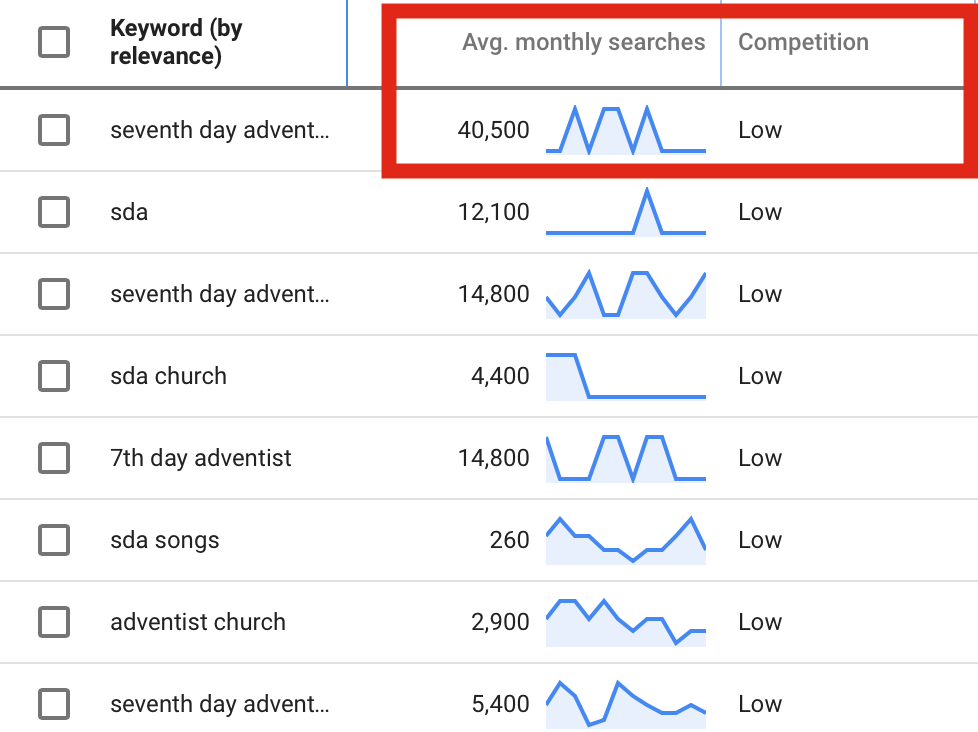Jamie Jean Schneider DommDigital Strategist, Social Media + Big Data, North American Division People value content that helps them make better decisions, answers their questions, and speaks to their core values or interests. Optimizing your content based on search engine queries (what people are searching for) helps you best match your products and resources to the needs and interests of your audience. We previously took a bird’s-eye look at using search results to find relevant content ideas. This section will go into greater depth for those ministries who want to focus more on creating digital content related to their mission and themes. If you’re a digital missionary looking to develop a content creation strategy that will reach beyond a geographical location, bookmark this section. This type of digital evangelism helps expand your messaging to new audiences who are hungry for the resources you can provide. Writer’s block? Find out what people are searching for.Keyword research is the core of what is known as SEO copywriting: writing content based on search engine optimization principles. Search engine optimization is a set of strategies that help organizations reach more of their online target audience. A website’s visibility in search engine results can be elevated by utilizing certain content development techniques. The higher a website ranks when a person googles search terms related to it, the more web traffic it receives. Visit SDAdata.org/SEO to learn more about SEO. Researching keywords removes much of the guesswork when trying to figure out which topics (related to your ministry and mission) make the most sense to explore for your content. It bridges the gap between your hunches, the data, and what information people need or want. This technique uses search query data from Google and other search engines to determine what kind of topics interest people. Creating content focused on commonly searched topics improves the visibility of your content in search results, which helps users find your ministry and increases the impact of your message. Use the following framework as a guide to creating content based on keywords. 1) Define the main topic of your online ministry. For example, you decide you want to start a blog to help Pathfinder leaders. “Pathfinders,” of course, is the topic. But if you title your blog, “Pathfinders,” it’s not specific enough to get search traffic. You have to differentiate from Nissan Pathfinders, Pathfinder International, and the Pathfinder role-playing game. Familiarity with your audience allows you to feature relevant keywords in your titles, headlines, and posts, such as:
While definitely more specific than “Pathfinder” alone, these are also considered broad-match keywords, as they can still have a wide variety of subtopics. They’re certainly good ideas, and posts on these topics can be helpful for your audience. However, they’re harder to rank for in Google search results without further specificity. Let’s say there is a burgeoning trend to create Pathfinder blogs. The broad topic of Pathfinder leadership is now a highly competitive arena. How do you get your blog to stand out? Considering the clear, central purpose of your ministry is a useful exercise for most types of digital content, but you’ll quickly need to distinguish how you’ll be providing something different from the competition. 2) Refine your topic. You have to get more specialized in your focus, so start brainstorming “niche topics”—subtopics within the broad subjects of Pathfinders and meetings and honors and campouts that people might be searching for information about. Some of these might be:
You can also start brainstorming possible blog, social media, and video posts for these subtopics and long-tail keywords:
Start by googling your topics, exploring related words or phrases, and come up with some post ideas. Then ask yourself the following questions:
Maybe you find that the knot-tying honor already has several articles that are well-written and popular. There are lots of positive comments on those posts. Therefore, another topic would be more effective in making your content stand out in search results. However, maybe there’s one particular knot you don’t feel the other writers have explained very well, even though the rest of the post is good. Maybe you’ve found a couple comments on other blogs about how they’d like more information on the hunter’s bend. You might then decide to write a post titled “How to teach the hunter’s bend knot.” This is a simple example of how research and testing can help shape meaningful content creation. 4) Test some more. Here’s where dedicated keyword research tools come in. These tools access data that tells how many people are searching for a certain keyword or keyphrase (search volume), as well as how much content already exists about that keyword (competition). The sweet spot is when you find a word or phrase that has high search volume and low competition. Here’s an example from Google Keyword Planner: Many keyword research tools provide a ratio of search volume and competition. Some tools do require a paid subscription, but some are completely free and offer similar data. These free keyword tools may also show related keywords or phrases, which can be helpful for coming up with good content ideas. Overall, you’ll get a general idea of what people are searching for, enabling you to create content that will connect your ministry with the needs and interests of your audience. Here are some recommended free or low-cost tools for keyword research or keyword ideas:
The tools below differ from true keyword research but can be very helpful for “informed brainstorming.”
5) Create content from keyword research. Once you’ve utilized these tactics and tools, it’s time to use this knowledge for your content planning. Keyword research does more than just tell you which words to use. It tells you which topics are popular, which topics are competitive, and what your best content opportunities may be. This is good news! This means that the organizational methods you learned for writing essays and research papers in school will now pay off in a practical way. For blogs and websites, begin by writing an introduction to a topic (one webpage), then cover the topic (another webpage), then cover related topics (more separate webpages) or background information (another separate webpage or two). It’s essentially writing an outline, and each section of the outline is a webpage. Blogs organized like this score highly in both search engine visibility and user-friendliness. For good examples of this, visit sdadata.org/seo and SDAdata.blog/DDandE. From a visitor’s perspective, this streamlines navigation within a specific topic. But, be careful not to take this concept to the extreme, creating a confusing maze of short pages. Remember that relevant topics and strong topic coverage have a stronger influence on search engine ranking than using individual words or phrases repetitively. The algorithm rewards quality writing and presentation. However, keywords do still matter! Keyword research helps us know what words and phrases people are using. We still want to use those words and phrases as often as we can on a page—naturally. If it sounds hokey to keep repeating a phrase, find another way to say it that means the same thing. Overall, you still want the content to read as naturally and conversationally as possible, as if you were telling this information to a friend. Click here for tips on how to write conversationally.
Here are some tips for thorough topic coverage in natural language that can be adapted for a variety of content types:
Work your way through a topic, creating as much applicable content as possible over multiple digital media posts and platforms. Content organization techniques that may help you include outlines, topic trees, bubble graphs, etc. Using these as your foundation for content creation helps you determine topical goals, objectives, and key takeaways, and makes the whole writing process easier. 2/9/2022 06:53:48 am
Great Article! Thank you for sharing this is a very informative post, and looking forward to the latest one Comments are closed.
|
Archives
August 2020
Categories
All
|
- Home
- BLOG
-
RESOURCES
-
RESOURCE MENU
>
- ADVENTIST IDENTITY GUIDELINES
- BIG DATA RESOURCES
- BRANDING, IMAGE & DESIGN RESOURCES
- CHURCH/MINISTRY SPECIFIC RESOURCES
- COPYRIGHT & TRADEMARK BASICS
- COURSES
- EMAIL RESOURCES
- GUIDANCE FOR HIRING SOCIAL MEDIA POSITIONS
- PODCASTS
- REPORTS & CASE STUDIES
- SOCIAL MEDIA RESOURCES
- (SOCIAL) VIDEO RESOURCES >
- TEXTING 4 CHURCHES
- TRACKING & ANALTYICS
- WATCH VIDEOS & TUTORIALS
- WEBSITE TIPS
- SOCIAL MEDIA GUIDELINES
-
RESOURCE MENU
>
- SEO
- Digital Discipleship & Evangelism
- COVID-19 RESOURCES
- eNEWSLETTER



 RSS Feed
RSS Feed